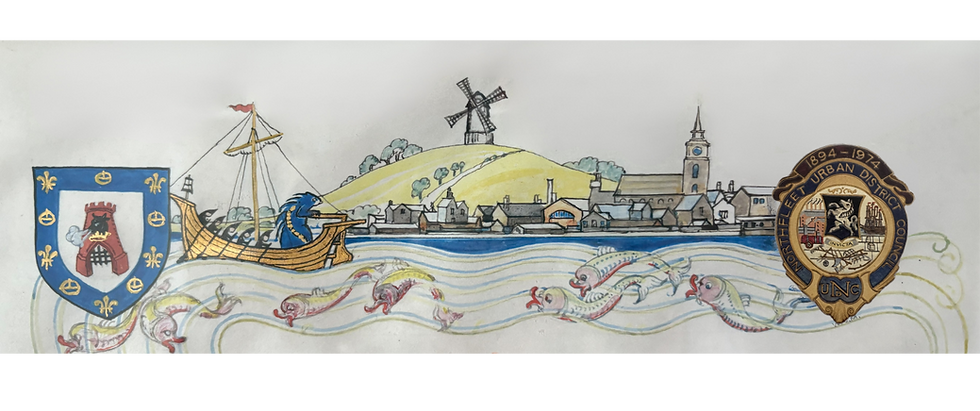UNTOLD STORIES REVEALED
Connecting to History through People and Places

Welcome to Gravesham History
This website is dedicated to uncovering and sharing the rich and captivating past of the borough of Gravesham.
Our mission is to preserve the area’s heritage and make it accessible and engaging for everyone—fostering a deeper appreciation for the people, places, and stories that shaped our community.
We welcome collaboration with anyone interested in local history projects and believe that working together helps bring our shared history to life.
The Borough of Gravesham was officially formed on 1 April 1974, uniting the historic towns of Gravesend and Northfleet with surrounding villages formerly part of the Strood Rural District. While now part of a single authority, each community proudly retains its own unique identity.
Gravesend, set on the River Thames, has long served as a gateway to London. Though often disproportionately known as the final resting place of Pocahontas, the town has a far broader story—marked by maritime trade, military presence, and market town heritage.
Northfleet’s story stretches back to Neolithic times, with significant archaeological discoveries pointing to early settlement and ritual activity. During the Roman period, Springhead—known to the Romans as Vagniacis—emerged as a key town along Watling Street. It featured an extensive temple complex, one of the most important religious centres in Roman Kent, serving both the local population and travellers. In later centuries, Northfleet developed into a major centre for cement production, shipbuilding, and industrial innovation—contributing to Britain’s economic growth.
The surrounding villages—including Higham, Shorne, Cobham, and Meopham—offer a rural counterpoint, with histories grounded in agriculture, feudal estates, and centuries-old religious and community life.
Together, these diverse places form Gravesham—a borough where ancient landscapes, industrial ingenuity, and everyday lives come together to tell a truly local story. This site explores those stories—through the people, the places, and the past they shaped.
Gravesham's Beginning

Parish boundaries map prior to 1 April 1935
The Traditional Parishes of Gravesham
The older parish boundaries of the area tell a very different story from the modern identity of Gravesham that exists in most people’s minds today.
Before the creation of the borough in 1974, the landscape was shaped by independent parishes, each with its own identity, governance, and sense of place.
-
Northfleet was historically much larger than Gravesend, surrounding it on two sides and including areas such as Singlewell and Ifield. It was a significant parish with its own deep history, stretching back to prehistoric times.
-
Milton-next-Gravesend and Denton were both distinct and separate from Gravesend. Though later absorbed into the growing town, they maintained their own local character and community.
-
Chalk, too, was an independent parish with strong rural and coastal roots, not historically part of Gravesend.
These traditional boundaries reflect a landscape of diverse, self-contained communities—quite different from the more unified identity suggested by the name Gravesham. Understanding these older divisions helps us better appreciate the richness and complexity of the borough’s history.
Our History Shared

Northfleet vs Gravesend
A Tale of Two Towns
Modern Gravesham gives the impression of a single, unified area—but a look at the past tells a very different story. Around 1900, Gravesend and Northfleet were neighbouring but distinct towns, each with its own history, identity, and role in the region.
Size and Land
At the turn of the 20th century, Northfleet was far larger in area than Gravesend. It stretched across approximately 3,900 acres, surrounding Gravesend on the west and south, and included outlying communities such as Singlewell, Ifield, Perry Street, and Rosherville.
In contrast, Gravesend covered a much smaller footprint—likely under 900 acres—focused tightly around the riverside town centre and its commercial port.
Civic Status
Gravesend had been granted borough status as early as 1835, with a charter dating back to Elizabethan times. It functioned as a bustling market and garrison town, closely tied to the Thames and national defence.
Northfleet became an Urban District in 1894, reflecting its growing population and industrial significance—particularly cement works and shipbuilding along the river.
Community Identity
Each town had a very different character:
-
Gravesend was urban, densely built, and known for its port, ferry, and military heritage.
-
Northfleet blended industrial expansion with deep rural roots, home to ancient churches and early settlements, but also to large cement factories and housing estates for workers.
Overlapping Histories
It's worth noting that Milton-next-Gravesend, now considered part of Gravesend, was a separate parish until 1915, and Denton and Chalk remained independent until 1935. That means much of what we now think of as "Gravesend" was actually outside the town’s official boundaries well into the 20th century.
Why It Matters
Understanding the historic relationship between Gravesend and Northfleet helps us see that Gravesham isn’t just one place—it’s a collection of long-standing communities, each with its own story. The older boundaries and loyalties still shape how people feel about where they live today.
The history stories on this website are deeply influenced by Gravesham’s strong military heritage. One of the cornerstone initiatives featured here is the Gravesham War Memorials Trust (GWMT). The Trust is dedicated to preserving the memory of local individuals who died in conflict, ensuring their stories continue to be remembered by future generations.